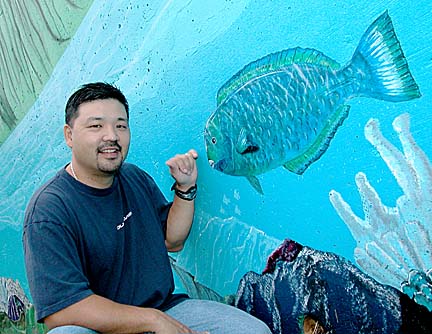

![]()
Kokua Line


![]()
Kokua Line

|
Question: I saw Lance Sakai paint a mural on the inside wall of Koolau Villages, which separates it from Kahekili Highway. I got to thinking, since nothing will grow on the ugly cement walls lining Kahekili Highway, why doesn't the state hire Lance to paint a uniform mural on these walls? Kahekili Highway walls
can expect DOT makeoverAnswer: There's nothing specifically prohibiting the state from having someone paint scenic murals along highway corridors like Kahekili, which are lined with steep walls.
Mainly, it's concern over maintenance and safety that has precluded the state Department of Transportation from going that beautification route, said Gary Choy, head of the DOT's Highways Division Design Branch.
The department already faces problems with graffiti, he noted. Just having to maintain a mural, much less worry about vandals disfiguring it, is a major reason against having a highway mural, Choy said.
There's also concern about it being a distraction to motorists, thereby becoming a safety concern.
However, the DOT does have its own plan to beautify Kahekili Highway. The estimated $2.25 million project will include landscaping with planters along the median, vines along the retaining wall, and "some coloring and retexturing of the walls," Choy said.
He anticipates advertising for this project in May.
Meanwhile, the 80-foot-by-12-foot mural you refer to can be seen from Keaahala Road, across from Kaneohe District Park, at the intersection of Keaahala and Kahekili Highway.
Sakai, 38, a free-lance graphic artist and former youth pastor for Grace Redemption Church, began the mural late last year as a community outreach project and eventually was hired by the Koolau Villages Association to complete it.
Early in the two-month project -- hindered by rainy weather -- up to 30 youngsters were involved in painting the mural, Sakai said. The mural depicts an ocean full of sealife, including dolphins and turtles, against the backdrop of the Koolau Mountain.
Q: Can you clarify who has the right of way in this situation: I am making a left turn. I observe no cars from the opposite direction. I notice there is a man with a baby in a stroller maybe a foot or two away from the curb, on the sidewalk. But by the time I get to the crosswalk, he is in the crosswalk. So who is wrong here? When I turned he wasn't there, but by the time I entered the crosswalk, he started walking in the crosswalk. I want to know because he started yelling at me that I should be more careful. Am I supposed to anticipate that this pedestrian who is on the sidewalk will be in the crosswalk by the time I reach there?
A: It would seem to make sense that since you were already making the turn that you would have the right of way.
However, this is a good example of motorists having to yield to pedestrians, even if it just means anticipating their moves.
"According to the law, when you (a driver) enter an intersection, even when you have the green light, you still have to yield to pedestrians lawfully within the crosswalk," said Honolulu police Capt. Bryan Wauke, of the Traffic Division.
Even if the pedestrian weren't in the crosswalk at the beginning of your turn, you should "anticipate the person walking into the crosswalk," he said.
Mahalo and Auwe
Mahalo to the city Department of Transportation Services for upgrading to the new colored traffic signal bulbs. They are so bright and just fantastic in the daylight! But auwe, at night they can be blinding, especially the green ones at smaller intersections where the traffic signals are spaced closer together. The glare is so strong that you might not see the pedestrians in the crosswalk. Could the lights be adjusted to minimize this glare? -- Steve(We received another complaint about the lights being too bright at night, but DTS Director Cheryl Soon maintains the new light emitting diode units "may appear brighter to some because of their fixed intensity, but they meet nationally accepted standards." In other words, DTS does not plan to change them.
(The city is replacing incandescent bulbs in its traffic signals with the LED units to save money. Soon said the LED units use only 10 to 12 watts, compared to 100 watts for the incandescent bulbs.
("The city expects to save substantially on energy costs while increasing the visibility of the traffic signals," she said.)
Got a question or complaint?
Call 529-4773, fax 529-4750, or write to Kokua Line,
Honolulu Star-Bulletin, 500 Ala Moana Blvd., No. 7-210,
Honolulu 96813. As many as possible will be answered.
Email to kokualine@starbulletin.com